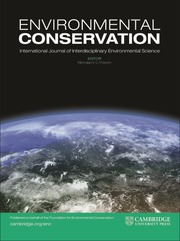Crossref Citations
This article has been cited by the following publications. This list is generated based on data provided by
Crossref.
Christie, T.
Steininger, M.K.
Juhn, D.
and
Peal, A.
2007.
Fragmentation and clearance of Liberia's forests during 1986-2000.
Oryx,
Vol. 41,
Issue. 4,
p.
539.
Randrianantoandro, J. Christian
Randrianavelona, Roma
Andriantsimanarilafy, Raphali R.
Hantalalaina, Elisoa F.
Rakotondravony, Daniel
Randrianasolo, Mamy
Ravelomanantsoa, Hery Lala
and
Jenkins, Richard K.B.
2008.
Identifying important areas for the conservation of dwarf chameleons (Brookesia spp.) in Tsingy de Bemaraha National Park, western Madagascar.
Oryx,
Vol. 42,
Issue. 4,
p.
578.
Hannah, Lee
Dave, Radhika
Lowry, Porter P
Andelman, Sandy
Andrianarisata, Michele
Andriamaro, Luciano
Cameron, Alison
Hijmans, Robert
Kremen, Claire
MacKinnon, James
Randrianasolo, Harison Hanitriniaina
Andriambololonera, Sylvie
Razafimpahanana, Andriamandimbisoa
Randriamahazo, Herilala
Randrianarisoa, Jeannicq
Razafinjatovo, Philippe
Raxworthy, Chris
Schatz, George E
Tadross, Mark
and
Wilmé, Lucienne
2008.
Climate change adaptation for conservation in Madagascar.
Biology Letters,
Vol. 4,
Issue. 5,
p.
590.
Andreone, Franco
Carpenter, Angus I
Cox, Neil
du Preez, Louis
Freeman, Karen
Furrer, Samuel
Garcia, Gerardo
Glaw, Frank
Glos, Julian
Knox, David
Köhler, Jörn
Mendelson, Joseph R
Mercurio, Vincenzo
Mittermeier, Russell A
Moore, Robin D
Rabibisoa, Nirhy H. C
Randriamahazo, Herilala
Randrianasolo, Harison
Raminosoa, Noromalala Rasoamampionona
Ramilijaona, Olga Ravoahangimalala
Raxworthy, Christopher J
Vallan, Denis
Vences, Miguel
Vieites, David R
and
Weldon, Ché
2008.
The Challenge of Conserving Amphibian Megadiversity in Madagascar.
PLoS Biology,
Vol. 6,
Issue. 5,
p.
e118.
Horning, Nadia Rabesahala
2008.
Madagascar's biodiversity conservation challenge: from local- to national-level dynamics.
Environmental Sciences,
Vol. 5,
Issue. 2,
p.
109.
Louis, Edward E.
Engberg, Shannon E.
McGuire, Susie M.
McCormick, Marilyn J.
Randriamampionona, Richard
Ranaivoarisoa, Jean Freddy
Bailey, Carolyn A.
Mittermeier, Russell A.
and
Lei, Runhua
2008.
Revision of the Mouse Lemurs,Microcebus(Primates, Lemuriformes), of Northern and Northwestern Madagascar with Descriptions of Two New Species at Montagne d'Ambre National Park and Antafondro Classified Forest.
Primate Conservation,
Vol. 23,
Issue. 1,
p.
19.
Allnutt, Thomas F.
Ferrier, Simon
Manion, Glenn
Powell, George V. N.
Ricketts, Taylor H.
Fisher, Brian L.
Harper, Grady J.
Irwin, Michael E.
Kremen, Claire
Labat, Jean‐Noël
Lees, David C.
Pearce, Timothy A.
and
Rakotondrainibe, France
2008.
A method for quantifying biodiversity loss and its application to a 50‐year record of deforestation across Madagascar.
Conservation Letters,
Vol. 1,
Issue. 4,
p.
173.
KELLER, EVA
2008.
The banana plant and the moon: Conservation and the Malagasy ethos of life in Masoala, Madagascar.
American Ethnologist,
Vol. 35,
Issue. 4,
p.
650.
Buchanan, Graeme M.
Butchart, Stuart H.M.
Dutson, Guy
Pilgrim, John D.
Steininger, Marc K.
Bishop, K. David
and
Mayaux, Philippe
2008.
Using remote sensing to inform conservation status assessment: Estimates of recent deforestation rates on New Britain and the impacts upon endemic birds.
Biological Conservation,
Vol. 141,
Issue. 1,
p.
56.
Gaveau, David L. A.
Epting, Justin
Lyne, Owen
Linkie, Matthew
Kumara, Indra
Kanninen, Markku
and
Leader‐Williams, Nigel
2009.
Evaluating whether protected areas reduce tropical deforestation in Sumatra.
Journal of Biogeography,
Vol. 36,
Issue. 11,
p.
2165.
Jenkins, Richard K. B.
Rabearivelo, Andriamanana
Andre, Chan Tak Chan Wai Mine
Randrianavelona, Roma
and
Randrianantoandro, J. Christian
2009.
The Harvest of Endemic Amphibians for Food in Eastern Madagascar.
Tropical Conservation Science,
Vol. 2,
Issue. 1,
p.
25.
Amelot, Xavier
and
André‑Lamat, Véronique
2009.
La nature enfermée ou l’aire protégée comme norme de protection d’un bien commun menacé.
Géographie et cultures,
Vol. 69,
Issue. ,
p.
81.
Ratrimomanarivo, Fanja H.
Goodman, Steven M.
Stanley, William T.
Naidoo, Theshnie
Taylor, Peter J.
and
Lamb, Jennifer
2009.
Geographic and Phylogeographic Variation inChaerephon leucogaster(Chiroptera: Molossidae) of Madagascar and the Western Indian Ocean Islands of Mayotte and Pemba.
Acta Chiropterologica,
Vol. 11,
Issue. 1,
p.
25.
Kull, Christian A.
and
Laris, Paul
2009.
Tropical Fire Ecology.
p.
171.
Muldoon, Kathleen M.
de Blieux, Donald D.
Simons, Elwyn L.
and
Chatrath, Prithijit S.
2009.
The Subfossil Occurrence and Paleoecological Significance of Small Mammals at Ankilitelo Cave, Southwestern Madagascar.
Journal of Mammalogy,
Vol. 90,
Issue. 5,
p.
1111.
Virah‐Sawmy, Malika
2009.
Ecosystem management in Madagascar during global change.
Conservation Letters,
Vol. 2,
Issue. 4,
p.
163.
Linares, Marjorie C.
Soto-Calderón, Iván D.
Lees, David C.
and
Anthony, Nicola M.
2009.
High mitochondrial diversity in geographically widespread butterflies of Madagascar: A test of the DNA barcoding approach.
Molecular Phylogenetics and Evolution,
Vol. 50,
Issue. 3,
p.
485.
Hall, Jaclyn
Burgess, Neil D.
Lovett, Jon
Mbilinyi, Boniface
and
Gereau, Roy E.
2009.
Conservation implications of deforestation across an elevational gradient in the Eastern Arc Mountains, Tanzania.
Biological Conservation,
Vol. 142,
Issue. 11,
p.
2510.
Vieites, David R.
Wollenberg, Katharina C.
Andreone, Franco
Köhler, Jörn
Glaw, Frank
and
Vences, Miguel
2009.
Vast underestimation of Madagascar's biodiversity evidenced by an integrative amphibian inventory.
Proceedings of the National Academy of Sciences,
Vol. 106,
Issue. 20,
p.
8267.
Steininger, M K
Godoy, F
and
Harper, G
2009.
Effects of systematic sampling on satellite estimates of deforestation rates.
Environmental Research Letters,
Vol. 4,
Issue. 3,
p.
034015.

